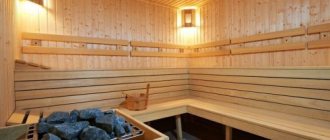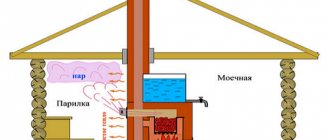There is nothing better for a Russian person than a Russian bathhouse. Not many people know that the Russian steam room is one of the most popular and famous baths in the world. In many parts of the world there are lovers of this entertaining form of recreation. There is a logical explanation for this. The healing properties, sung since ancient times, are increasingly attracting steam lovers. The most important thing is that there are no age restrictions. From time immemorial, people have been steaming, as depicted by E.M. Korneev in the painting “Russian Bath”, painted in 1812.
Features of Russian doubles
Subsequently, the steam room came into use and became a national symbol , uniting people of different personalities, professions and religions in this activity. Artist V.A. Plotnikov the painting “In the Bath” from 1898 captured this moment. Many other famous artists and performers were not averse to taking a steam bath and rejuvenating both soul and body. In modern society, Russian steam rooms are common in rural areas, but in cities, a movement for a healthy life is slowly developing, and with it Russian steam rooms.
How not to mention the art of massage with brooms ? It’s art because one must also be able to masterfully wield this bath item. Brooms, as before, are used from birch, fir, oak, and linden. The choice largely depends on the health benefits you want to achieve. We know the healing natural effect of steam. Together with a wonderful broom and an experienced bath attendant, time will fly by unnoticed and useful. The canvas by Alexey and Sergei Tkachev “Family Bath” from 1982-83 conveys all the beauty and life of the family. All the attributes for a pleasant time in the bathhouse are visible.
Russian bath options
As the ancestors said, purification of the soul and body . Of course, our mother nature also helps in many ways; what would we do without medicinal plants and herbs. It turned out well to depict a truly Russian maiden after a steam room by the artist V.A. Plotnikov. in the painting “In the Bath” from 1898.
According to research, the steam room removes from the body:
- slags;
- excess water;
- toxins;
- takes away fatigue and stress.
As Arkady Plastov showed in the painting “Spring” of 1954, the most important feature that the Russian steam room has is, of course, the design itself. From time immemorial, the steam room was built from a wooden frame, which gives a colossal effect during the bathing process. Many foreign travelers have written about our Russian bathhouse.
Traditional Russian steam room is divided into three types:
- in black
- in white;
- inside the oven.
Five “NOT” for a fir broom
Everyone wants to get the maximum benefit from a bathhouse by using various brooms.
Regarding fir, it is important to remember 5 important recommendations:
- Do not dry the broom in the open sun - ultraviolet radiation will dry out the needles, they will turn yellow and quickly fall off.
- Do not constantly wet the broom during storage - it will lead to the formation of mold fungi, which will quickly destroy the needles.
- Do not steam in boiling water - the branches will become bald, and essential oils with nutritional components will quickly be destroyed.
- Do not store the broom in the dressing room - excess moisture will lead to rotting processes in the needles, which will make the broom unsuitable for subsequent use.
- Do not apply force to the broom - the needles are quite sharp even after steaming, so you need to work with this tool very carefully, moving the broom in the direction of the growth of the needles.
And remember, fir brooms are not suitable for long-term storage. A fresh cut works best, as it retains the needles when steamed and releases more nutrients when heated.
Black steam room
The traditional steam room was called “black” and was hot and smoky . A stone stove was placed in the corner of the bathhouse, which heated and smoked heavily. To avoid burning our feet, straw was placed on the floor, as the floor became very hot. Along the walls, trestle beds-shelves were made, and steam lovers lay down or sat on them, enjoying the aromatic, delicious kvass and the smell of straw.
Kvass played a significant role , since it was periodically poured over the brazier, and the steam room was filled with the aroma of the drink, and the air became more humid. Because of the open fireplace, the heat warmed not only the stones, but also the wooden walls. The smoke came out through a vent in the ceiling or through the door. Usually there was a boiler for hot water and a heater made of stones. The bathhouse was heated with wood, preferably hardwood. Z.I. Letunov, in his work “Russian Baths,” reflected the whole essence of those times.
TERMS AND DEFINITIONS USED
7. Personal data - any information relating to a directly or indirectly identified or identifiable individual (subject of personal data).
8. Operator - a state body, municipal body, legal or natural person, independently or jointly with other persons organizing and (or) carrying out the processing of personal data, as well as determining the purposes of processing personal data, the composition of personal data to be processed, actions (operations) performed with personal data.
9. Processing of personal data - any action (operation) or set of actions (operations) performed using automation tools or without the use of such means with personal data, including collection, recording, systematization, accumulation, storage, clarification (updating, changing), extraction, use, transfer (distribution, provision, access), depersonalization, blocking, deletion, destruction of personal data.
10. Providing personal data - actions aimed at disclosing personal data to a certain person or a certain circle of persons;
11. Destruction of personal data - actions as a result of which it becomes impossible to restore the content of personal data in the personal data information system and (or) as a result of which material media of personal data are destroyed.
12. Blocking of personal data - temporary cessation of processing of personal data (except for cases where processing is necessary to clarify personal data).
Steam room inside the oven
The word “laznya” in Ukrainian comes from another type of steam room - a sauna inside a stove. The stove was large enough to fit into. The stove was heated, water was heated in cast iron, the heat was removed and the floor was covered with straw. After that, you could climb in and wash yourself inside the oven.
Now the Russian steam room is becoming increasingly popular among young people. Quite often, a steam room is built next to a pool or bet containing cool water. Scientists have proven that the ancient tradition of jumping steamed into cold water or rolling in snowdrifts has a beneficial effect on the body, strengthening it as a whole, and also has a positive effect on the immune system and the heart and strengthens the walls of blood vessels, this process is clearly visible in the creation of Nikolai Feshin “In the Bath” 1923 of the year.
After a dull workday, a Russian steam room is just what the doctor ordered. It is recommended to almost everyone. In the bathhouse you can spend a fun and comfortable evening with friends, hold an informal meeting, or enjoy pleasant aromas and improve your health alone. It’s not for nothing that even in the old days a bachelorette party was held in a bathhouse, as Firs Zhuravlev tells us in his creation “Bachelorette Party in a Bathhouse” from 1885.
Paintings by famous artists on the theme of Russian steam room
As the outstanding German scientist Olearius wrote, “Russians adhere to the custom of washing in a steam room, and therefore they have many baths in cities and towns.” As we see in the photograph “Bath” by Zinaida Serebryakova.
GENERAL PROVISIONS
1. This document defines the policy of IP Skiba A.A.
(hereinafter referred to as the Operator) regarding the processing of personal data (hereinafter referred to as the Policy). 1. This Policy applies to all information that an Individual Entrepreneur (OGRNIP: 316366800149986, INN: 366412148927, registration address: 394028, Montazhny 12e, office 1, Voronezh, Voronezh region, Russia) and/or its affiliates may receive about the user while he is using the site.
2. The use of the site by the subject of personal data means the unconditional consent of the subject of personal data with this Policy and the conditions for processing his personal data specified therein; in case of disagreement with these conditions, the personal data subject must refrain from using this resource.
3. This Policy applies only to the website. The Operator does not control and is not responsible for third party websites, which the subject of personal data can access via links available on the website. On such sites, other personal information may be collected or requested from the user, and other actions may be taken.
2. This Policy has been developed in accordance with the current legislation of the Russian Federation on personal data.
3. This Policy applies to all processes of collection, recording, systematization, accumulation, storage, clarification, extraction, use, transfer (distribution, provision, access), depersonalization, blocking, deletion, destruction of personal data carried out using automation tools and without the use of such means.
4. The policy contains information that is subject to disclosure in accordance with Part 1 of Art. 14 Federal Law “On Personal Data”, and is a publicly available document.
5. The operator operates at the address: 394028, Montazhny 12e, office. 1, Voronezh, Voronezh region, Russia.
6. Skiba Alena Alekseevna (phone, e-mail) was appointed responsible for organizing the processing of personal data.
PURPOSES OF PROCESSING PERSONAL DATA
13. The operator processes personal data for the following purposes:
1. for the execution of an agreement to which the subject of personal data is a party or beneficiary or guarantor;
2. to conclude an agreement on the initiative of the subject of personal data or an agreement under which the subject of personal data will be a beneficiary or guarantor;
3. to process incoming requests from individuals for the purpose of providing information services;
4. to achieve the goals provided for by an international treaty of the Russian Federation or law, to implement and fulfill the functions, powers and responsibilities assigned by the legislation of the Russian Federation to the Operator;
5. to promote the Operator’s goods, works, and services on the market by making direct contacts with the subject of personal data using communication means.
PRINCIPLES FOR PROCESSING PERSONAL DATA
23. Processing of personal data is carried out on the basis of the following principles:
1. The processing of personal data is carried out on a legal and fair basis;
2. The processing of personal data is limited to the achievement of specific, pre-defined and legitimate purposes. Processing of personal data that is incompatible with the purposes of collecting personal data is not permitted;
3. It is not allowed to combine databases containing personal data, the processing of which is carried out for purposes incompatible with each other;
4. Only those personal data that meet the purposes of their processing are subject to processing;
5. The content and volume of personal data processed correspond to the stated purposes of processing. The personal data processed is not redundant in relation to the stated purposes of processing;
6. When processing personal data, the accuracy of personal data, their sufficiency, and, if necessary, relevance in relation to the stated purposes of their processing are ensured.
7. The storage of personal data is carried out in a form that makes it possible to identify the subject of personal data no longer than required by the purposes of processing personal data, unless the period for storing personal data is established by federal law, an agreement to which the subject of personal data is a party, beneficiary or guarantor. The processed personal data is subject to destruction or depersonalization upon achievement of the processing goals or in the event of loss of the need to achieve these goals, unless otherwise provided by federal law.
TRANSFER OF PERSONAL DATA TO THIRD PARTIES
21. To achieve the purposes of processing personal data and with the consent of the subjects of personal data, the Operator provides personal data or entrusts their processing to the following persons:
1. government agencies;
2. individuals who are in labor and civil relations with the Operator’s counterparties.
3. individuals who are in labor and civil legal relations with the Operator.
22. In order to fulfill contractual obligations or requirements of federal legislation, the Operator receives personal data from the following third parties:
1. Partners or other persons in accordance with a civil law agreement.
LEGAL BASIS FOR PROCESSING PERSONAL DATA
14. The legal basis for the processing of personal data is:
1. Legislation of the Russian Federation in the field of personal data based on the Constitution of the Russian Federation and international treaties of the Russian Federation and consisting of Federal Law of July 27, 2006 No. 152-FZ “On Personal Data” and other federal laws defining cases and features of the processing of personal data ;
2. consent to the processing of personal data, the conditions of which are confirmed by the subject of personal data when working with the feedback form on the Operator’s website;
3. civil contracts concluded by the Operator with counterparties, annexes to these contracts.
RIGHTS OF PERSONAL DATA SUBJECTS
38. The subject of personal data has the right:
1. to receive personal data relating to a given subject and information regarding their processing;
2. to clarify, block or destroy his personal data if they are incomplete, outdated, inaccurate, illegally obtained or are not necessary for the stated purpose of processing;
3. to withdraw his consent to the processing of personal data; - to protect their rights and legitimate interests, including compensation for losses and compensation for moral damage in court;
4. to appeal the actions or inaction of the Operator to the authorized body for the protection of the rights of personal data subjects or in court.
5. To exercise their rights and legitimate interests, subjects of personal data have the right to contact the Operator personally or with the help of a representative.
6. The request must contain the information specified in Part 3 of Art. 14 Federal Law “On Personal Data” and should be sent to the address specified in clause 1.5 of the Policy.
Installation of a steam room in a bathhouse
The process of constructing a steam room in a bathhouse consists of several main stages:
- development of a design for a bathhouse and all its components: dressing room, steam room, internal contents of the steam room (what kind of shelves, heater, lighting, accessories and even stones are needed for the steam room in the bathhouse);
- calculation of the amount of materials needed;
- design and calculation of ventilation ducts;
- laying a brick stove on a concrete base;
- finishing of walls and ceilings with waterproofing and heat-insulating materials;
- covering the steam room with natural wooden materials (lining, boards)
- placement of shelves (beds), installation of lighting and lighting;
- filling with decorative elements and special devices.
As you can see, making a steam room in a bathhouse is not difficult; it is important to be patient, as well as certain knowledge and skills.











